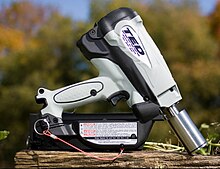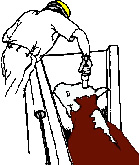Battle gun
The captive bolt pistol is a device that in the slaughter for stunning of slaughter animals is used. This is to save the animals unnecessary suffering .
The devices are mostly bolt guns and, more rarely, bullet guns . In contrast to the bolt gun, there is a risk of ricochets and other accidents similar to that of firearms (see also bolt gun ).
Hugo Heiss (* August 5, 1863, † September 27, 1936), former director of the slaughterhouse in Straubing, is considered the inventor of the battle gun . In Switzerland , however, Benjamin Siegmund is seen as the author of the first battle gun, who was the slaughterhouse manager of the Basel-Stadt abattoir from 1868 to 1909, but renounced a patent for his invention of a stunning device so that his device could be copied and widely distributed. Siegmund was a committed animal rights activist and u. a. Founding President of the Basel Animal Welfare Association. The impetus for Swiss animal protection legislation also came from Basel.
application
Animals with thick scalps and strong skulls such as cattle or horses are anesthetized with a targeted shot in the brain . With cattle, the butcher aims at the imaginary intersection of two lines that connect the horn attachment point and the opposite eye. In horses, slightly to the side of the middle at the height of the mane base. Pigs are only stunned with the nail gun when they are slaughtered at home. The nail gun is placed firmly on the forehead two finger widths above the sow's eyes. For rabbits and poultry, smaller and lighter designs are used that only work with spring force instead of cartridges.
Designs
There are three forms:
- penetrating
- Devices in which the bolt penetrates the brain of the slaughtered animal.
- dull
- Devices with a flattened bolt end that do not penetrate into the brain.
- gas injecting
- Devices with hollow bolts which, when blown, inject gas under pressure into the skull of the slaughtered animal.
The latter were particularly common in the United States until the onset of BSE . However, in addition to destroying the brain, they also destroy the spinal cord and can thus bring any pathogen prions into the meat.
For stunning animals of various sizes ( rabbits , poultry , cattle ), devices of various sizes and with various trigger mechanisms are manufactured. The rule is: the bigger the animal, the bigger the bolt gun.
The nail gun essentially consists of:
- Barrel with bolt head
- Trigger
- Firing pin with firing pin spring
- Firing pin
- Bolt return spring
- Rubber buffers (rubber rings or rubber sleeve)
ammunition
Blank cartridges are used as ammunition for the nail gun , the propellant charge of which pushes the bolt out. The cartridges are color-coded. The different colors indicate the type of slaughter animals for which these cartridges are used:
- green
- weak charge
- for pigs and small animals (calves, sheep)
- yellow
- medium charge
- for cows, horses and light oxen
- blue
- strong charge
- for heavy oxen and bulls
- red
- extremely strong charge
- for the heaviest animals.
Laws and regulations
Germany
Gunsight guns are called guns in gun law . Possession, acquisition and handling of these guns and the associated ammunition are regulated in numerous laws, administrative regulations and ordinances. A slaughter gun that is dedicated to stunning animals for slaughter is not considered a weapon within the meaning of Section 1 of the Weapons Act.
Switzerland
In Switzerland, the handling of bolt guns is regulated by the BSE leaflet on slaughter, stunning of cattle, sheep and goats . Possession, acquisition and handling of these devices and the associated ammunition are stipulated in other regulations.
Individual evidence
- ↑ Animals were never an issue for the veterinary authorities. Anniversary celebration of 100 years of the Swiss Veterinary Service.
- ^ Text of the Arms Act
- ↑ Administrative regulations for explosives and weapons
- ↑ Working with guns (UVV) BGV D9
- ↑ BSE leaflet on slaughter, stunning of cattle, sheep and goats (accessed on December 11, 2009) ( Memento of March 8, 2016 in the Internet Archive )





